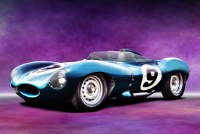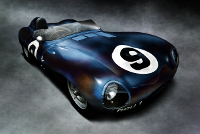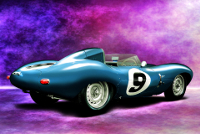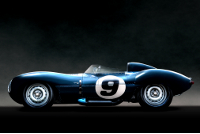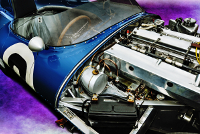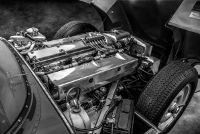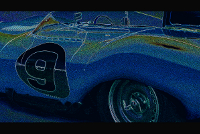Jaguar D-Type Short Nose, XKD 515, 1955
Location:
Elegance at Hershey, 2013
Owner: James W. Taylor | Gloversville, New York
Prologue:
Image Source: Nikon D700 (12.1 MP)
Image 7: Vignette cropped vertically to 10 MP.
References:
- HowStuffWorks: The auto section of HowStuffWorks provides a nice ten-page history of the D-Type's development, and its career at Le Mans.
- Hemmings: Untouched by Time, by Jim Donnelly, May, 2008
Among a series that has always been raced and run hard, XKD 515 is one of the cleanest, most original D-Types known. The car retains its original chassis and motor, as well as most, if not all, of its original bodywork. The car was originally purchased by Colonel R.J. "Ronnie" Hoare, who would become better known a decade later as the chairman of Maranello Concessionaires, the official Ferrari importer for the UK. While occasionally raced in period, 515 was not used as an earnest competition device, and therefore survived the tumult of 1950s motorsport with very little wear and tear.
In the midst of all the heritage talk of late, there's been mention of Aston Martin as the quintessential British sports car, or even of Morgan as the oldest and truest British sports car. And it's all codswallop. Jaguar, (or Jag'you'are, thank you very much), are the three words that spell sports car for Great Britain. And while others cannot give proper justice to the name of the animal—family: Panthera onca—the mechanical form of this Jaguar is a true masterpiece. In contrast, the Aston Martin DBR1 is formulaic in the continental sense. By clothing a tubular chassis in Romanesque curves and opting for exotic magnesium for the paneling, the DBR1 is something like Scaglietti's take on the W-196R. Not so the D-Type, which is one of few vehicles to feature a firmly British personality, and manage to be revolutionary at the same time.
Fast, beautiful, and three times victorious at Le Mans, there is no greater expression of the post-War British sports car. I will defend that statement with the suggestion that the D-Type represents original thinking. In the way of similar things British, the D-Type is like a thoroughbred version of the Mini. Packaged with a tubular spaceframe, bolted to a monocoque, seated with narrow cross-plys, each fitted with discs—it's a very sensual piece. And so the D-Type looks like nothing else because it is built according to a unique formula.
The D-Type benefited from the styling philosophy practiced by Malcolm Sayer—to say nothing of similar contributions by Frank Costin. At least five steady years of racing development benefited the twin-cam, straight 6-cylinder motor, while a series of high-speed record attempts using purpose-built Jaguars in years prior taught the company a lot about aerodynamics at the upper limit of sports-racing cars. Thus the Jaguar D-Type quickly leapt into contention among the best from Ferrari and Maserati, a path paved for all by Mercedes' unfortunate withdrawal from motorsport.
In 1954 Dunlop developed a lightweight alloy wheel, much to the advantage of British sports cars from Jaguar and Lister. The entire unit is three pieces. First, the rim is formed of extruded aluminum. Next the centers are formed of pressed aluminum. And finally a steel presser plate fastens the hub and provides a seat for the knockoff. A series of circular cooling vents rounds the perimeter, a pattern reminiscent of BMW 328 survivors in the post-War era, but more particular to Frazer-Nash racers, Bristol cars, and oddballs like the Jowett Jupiter and Healey Silverstone. As practically any source will tell you, inside those new wheels is a set of Dunlop disc brakes, the competitive kicker in an already speedy package.
Jaguar's long-time design chief, Malcolm Sayer, came to the company by way of the aircraft industry. Unsurprisingly, the D-Type's central monocoque tub is comprised of light alloy that has been folded, riveted, and arc-welded according to contemporary aviation practices. A tubular section holds the motor up front, while a sparse tail assembly covers the back axle, fuel tank, and not much else. The arrangement makes the car slightly nose-heavy, but the balance settles at full chat. Some nose lift might surface at the limit, though it remains quite easy to drive flat out according to those so privileged to do so.
In that world of constant comparisons, the D-Type ethic is about slipperiness at speed, whereas the Aston Martin DBR1 is all about poise. The D-Type's motor is tilted eight degrees to port, lowering the bonnet line, and with it the height of the windscreen and headrest fairing. Upon debut, the D-Type was good for better than 170 miles per hour, and that with its formative 3.4 litre powerplant. Later cars graduated to a factory prepared 3.8 litre unit. Conversely, the more modestly powered DBR1 was good for about 155 mph. To be fair in this comparison, better counterpoint to the D-Type would have been the 3.7 litre Aston Martin DBR2, except that the project was rendered obsolete. (See the following item.)
The D-Type would place a close second at Le Mans in 1954, losing out to the 4.9 litre Ferrari 375 Plus of José Froilán González and Maurice Trintignant. The next three years, however, belonged to the D-Type. Built to triumph at Le Mans, no other car had the lightness, the slipperiness, or the sheer stopping power of the D-Type—at least, not all three of those qualities in such abundance. And yet the advantage did not run out, but rather the regulations changed. From 1958 a 3-litre rule was imposed, shifting the game to Ferrari's 250 Testa Rossa, and Aston's DBR1, both of which would have their respective day on top of the podium.
Motor: 3,442 cc straight 6-cylinder, iron block and aluminum head | 83 mm x 106 mm | 9.0:1 compression
Valvetrain: DOHC, 2 valves per cylinder
Aspiration: triple Weber 45 DCO3 carburetors
Drivetrain: 4-speed gearbox, rear-wheel drive
Front Suspension: independent double wishbones with torsion bars, telescopic shock absorbers, and anti-roll bar
Rear Suspension: rigid axle with transverse torsion bar and telescopic shock absorbers
Architecture: magnesium alloy semi-monocoque chassis with tubular spaceframe, aluminum bodywork
Kerb Weight: originally 898 kg (1,979 lbs), later 875 kg (1,929 lbs) with thinner bodywork
Wheelbase: 2,228 mm (90 inches)
0-60: 4.7 seconds
Top Speed: 280 km/h (174 mph)
Etymology:
The 'D' designation takes the second spot in a continuum of Jaguar sports cars that began with the C-Type in 1951. 'C' stands for 'competition' in the case of that particular car, a racing version of the road-going XK120. However, 'D' stands for nothing other than 'comes after C.' The E-Type road car is a direct development of the D-Type. 'E' comes after 'D.' Internally, however, Jaguar stuck to the XK designation, hence the chassis number XKD 515 in the case of our car here, not to mention the American habit of referring to the E-Type as the XKE. Also, short nose cars were followed by long nose cars, each of which is distinct.
Figures:
Close estimates account for 71 total D-Types, broken down into 18 factory competition cars and 53 privateer cars. These figures are high compared to the four factory DBR1 cars built by Aston Martin, plus one privateer car. The numbers bear the truth of the gap between these automakers—Jaguar with years of experience and respectable production capacity, Aston Martin with bold aspirations and comparatively few resources. Also note that a small number of D-Type cars were converted to XKSS roadster configuration, including two by the factory. Other D-Type and XKSS cars have swapped bodies back and forth, notably XKD 575, which went from XKSS to D-Type and then back to XKSS form. Only 16 original XKSS cars were built before fire destroyed the Browns Lane warehouse in which the chassis and tooling were housed.
British Icons: The Personification of British Sporting Design in the D-Type
In the mid 1950s arose a sense of British sporting design; it was also seen in Austin Healey, Lister, and Lotus, but if you wish to personify this aesthetic, the full stretch is that a British sporting design is like a D-Type. When the XK120 appeared in 1949, it showed the way forward for British sports cars, and to no small extent sports cars in general. However, William Lyons found clear guidance for the XK120 design among pre-War greats, following the likes of the BMW 328 and Talbot-Lago T150 C. The D-Type, on the other hand, is where all of that inspiration was headed, and by the time it arrived off the drafting pen of Malcolm Sayer, the ideas that once came from other products in other countries had either been perfected or replaced by a particular flavor of British engineering. At last, Great Britain developed its own winning aesthetic—seductive, desirable, and conceived in-house.
The D-Type is a voluptuous form from any angle. Even in profile, the curvaceous front shoulders and deeply sculpted nose are as well formed and broad as a champion swimmer's, while the haunches are enunciated in a way that reveals a smooth, yet, powerful fluidity throughout the tail. The car is also lithe, purporting to house an organic skeleton underneath its bulges and swoops. Yet its skin is riveted together, projecting an aircraft-like emotion to match the dull, three-piece metal wheels. And louvres join the circus, lest we forget the cardinal rule of ventilation needed to let racing cars breathe. Among so many beautiful Jaguar designs, the D-Type lives up to its feline pedigree.
Perfect Package: D-Type Dimensions Compared to the C-Type
Remarkably, the D-Type is smaller than the C-Type it superseded. A testament to the engineering savvy that went into its design, measurements for the D-Type's total length, wheelbase, front and rear track, and height are all shorter than for the C-Type.
Last Updated: Feb 28, 2025
Editor's Picks
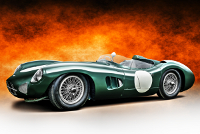
© Copyright 2008-2025, 12cylinders.com | images and text by Dominic Anthony

